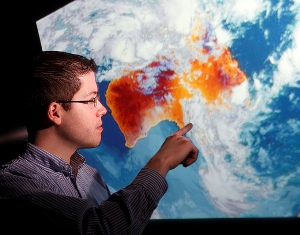Never mind Ronaldo: watch out for El Niño at the World Cup in Brazil
Release Date 10 May 2014

As Hodgson prepares to announce his squad, scientists say increased risk of warmer weather in Brazil could dent England's World Cup hopes
England's chances at the World Cup in Brazil this year may have suffered a setback - from the weather forecast.
Three Lions coach Roy Hodgson has said his side had hoped to avoid playing in warmer conditions, in which European teams are known to struggle.
But climate scientists at the University of Reading have some bad news for England fans. Climatic forecasts suggest that conditions could be especially hot, dry and sunny - even at venues in the more temperate south of the country, where the team is due to play its crucial final two group matches.
Dr Nick Klingaman, a climate scientist at the University of Reading, said the chances of El Nino conditions being in place by July - which would increase the likelihood of hot winter weather in Brazil - were now around 60%.
The chances of an El Nino event by November have now risen to 70-80%.
"It is now looking likely that there will be an El Nino event in 2014, with the chances of one occurring in time for the World Cup tournament more than twice the average," he said.
"If it does occur, it would increase the risk of uncomfortably hot and dry conditions in Brazil during June and July, especially in the southern and eastern parts of the country, where England are playing their second and third group games (in Sao Paulo, against Uruguay, and Belo Horizonte, where they play Costa Rica).
"The venue for their first game, Manaus, where they take on Italy, is in the tropical north of Brazil and so is already likely to be very hot and humid, and conditions are unlikely to be made worse by El Nino. However, if players and coaching staff were hoping for milder and more favourable conditions for their remaining matches, it looks more likely that they could be disappointed.
"On average, El Nino increases June and July maximum temperatures near Rio de Janiero by 0.9 degrees Celsius - and would increase the probability of very warm temperatures, as well as reducing cloud cover and increasing sunshine, increasing the risk of heat-related fatigue."
The average maximum temperature in Rio during these months is 25.5C, with a record maximum of 36.0C.
"While a one degree increase may seem insignificant, not all days will be affected equally," Dr Klingaman said.
"Extreme temperatures often change by much more than the monthly average. A one degree increase in the monthly average is equivalent to half of all days warming by two degrees, or one-third of all days warming by three degrees."
Q&A - by Dr Nick Klingaman, University of Reading
What is El Nino?El Nino refers to unusually warm ocean temperatures near the equator in the central and eastern Pacific Ocean. El Nino events often develop in June-August, reaching their peak in December-February before fading in March-May. Because tropical rainfall is strongly tied to ocean temperatures, El Nino typically increases rainfall over the Pacific Ocean and decreases rainfall on the continents surrounding the Pacific.
What other effects can it have?
El Nino is linked to drought and heatwaves in India, southeast Asia, eastern Australia and eastern South America. In North America, El Nino increases the risk of winter flooding in Mexico and the southwestern United States, including California, which has been experiencing a record drought. Northern and eastern North America is often warmer and drier than normal during El Nino. There is little evidence that El Nino affects European weather patterns. An El Nino occurs about every 2-5 years and rarely lasts for more than one year.
How is the forecast made?
There are 16 state-of-the-art computer models from prediction centres around the world, and around half of them are forecasting an El Nino - including two of the most historically reliable models, from the European Centre for Medium-range Weather Forecasts, based in Reading, UK, and the US National Centers for Environmental Prediction.
How reliable is the forecast?
The latest forecasts were produced in April and May. The reliability of El Nino forecasts increases during the year, as the conditions in the Pacific Ocean become more easily predictable. These latest forecasts of a 60% chance of an El Nino are more reliable than those issued in March, which indicated only a 50% chance. It will be important to monitor the upcoming forecasts in late May and early June, which will provide a clearer indication of whether an El Nino will develop by the time of the World Cup.
Where do the measurements come from?
Scientists detect El Nino and its opposite, La Nina, with ocean buoys that are part of the Tropical Atmosphere Ocean (TAO) array. Information from TAO is critical for monitoring and predicting El Nino and La Nina. However, TAO has been poorly maintained since 2012, due to cuts in U.S. and Japanese funding to repair this essential infrastructure. In the last two years, nearly half of the buoys in the array have stopped sending data. To protect life, agriculture and economies throughout the tropics and in the Americas, it is crucial that the TAO array not be allowed to "go dark".